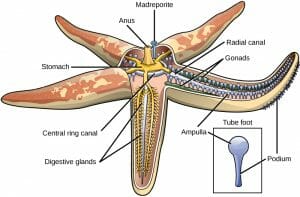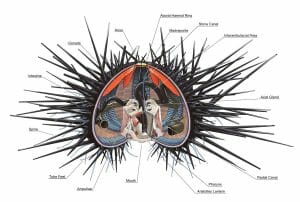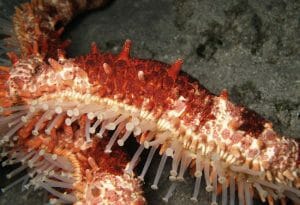Echinoderm Definition
An echinoderm is a member of the phylum Echinodermata which contains a number of marine organisms recognized by their pentamerous radial symmetry, calcareous endoskeleton, and a water vascular system which helps operate their small podia. Podia are small extensions of flesh which are operated by water pressure and muscles, and controlled by the nervous system of the echinoderm. The calcareous endoskeleton is made of many small plates that overlap under the skin, forming an armor and a structural form for the organisms. Examples of an echinoderm include a starfish, a sand dollar, a brittle star, a sea urchin, and a sea cucumber. There are around 7,000 echinoderm species, and they can range from less than an inch to over three feet in diameter.
Echinoderm Characteristics
An adult echinoderm is radially symmetrical, meaning their body parts extend outward from the mouth. An echinoderm usually has 5 parts, making them pentamerous. Curiously, echinoderm larva are bilaterally symmetrical and must convert to radial symmetry. Typically, the mouth is surrounded by a central disc, which lead to outward to grooves housing rows of podia. These grooves are called ambulacral grooves and may lead to individual legs as in a starfish, or can be simple slits like in a sand dollar. The endoskeleton of an echinoderm is made up of individual pieces, known as ossicles. The ossicles are covered by epidermis, or skin. In some echinoderms, like sand dollars and sea urchins, the ossicles form a rigid shell known as a test. On the other end of the spectrum, sea cucumbers have very few ossicles and they are separated from each other. These ossicles may also fuse to form various structures, such as the brittle spines of the sea urchin.
The water vascular system is an essential part of echinoderm biology. While the system differs in different classes of echinoderm, its basic operation is the same. The system consists of a series of fluid-bearing tubes that connect in a ring-like structure throughout the organism. The system connects to the podia, and can be used to fill them with fluid which elongates and stiffens the podia. This is accomplished by a series of sacs and muscles within the ring canal, lateral canals, and Polian vesicles, some of which can be seen in the image below.
An echinoderm uses this unique system for a number of lifestyles. The podia can be used as feet, to move in a coordinated fashion to direct the echinoderm. The podia can also be used to hold on to the substrate, small stones for protection, or a number of objects to use as camouflage. Some echinoderms are sessile filter feeders, while others actively hunt their prey. While some filter feeders direct food to their mouths, sea stars are known for pushing their stomach outside of their body to feed on prey. Other echinoderms have a complex mouth structure known as Aristotle’s lantern, which houses teeth and allow them to bite and scrape algae from the surface of rocks.
An echinoderm generally has simple circulatory and nervous systems, which circle through their bodies. Their hemal system is open to the environment and allows for gas exchange through a serious of channels throughout the body. The nervous system is a ring of nerves which connect to all parts of the organisms. This is thought to help an echinoderm interact with all directions it faces equally, maximizing the benefits of its radial symmetry.
Echinoderm Reproduction
Echinoderm reproduction is varied and often complex. Most echinoderms reproduce sexually, while a few species are known to reproduce asexually or through budding. Most specious are dioecious, or contain two distinct sexes, while other species are hermaphroditic and each individual carries both sexual organs. Either way, the gametes of an echinoderm are developed in the genital sinus, which may take a number of forms. Many species then broadcast their gametes into the environment. Gametes that successfully find one another and fertilize will become a new larva.
This new larva, which is virtually microscopic, will swim and ride the currents to a favorable place on the ocean floor. During a complex metamorphosis, the larva will reorient its body plan from being bilaterally symmetrical to being radial symmetrical. This involves moving the mouth and anus, as well as rearranging many other body parts internally. Once this transition is complete, the echinoderm then assumes a life feeding along the ocean floor. In areas where larval survival is low, an echinoderm may brood and care for their larva before they are released. In polar waters and deep-sea areas this helps insure a higher rate of larva survive into adulthood.
Examples of Echinoderm
Sea Stars
Sea stars are among the most ambulatory, or mobile, of all echinoderms. Sea stars, or starfish, use their many podia to slowly crawl over most surfaces. Starfish are mainly predatory, feeding on invertebrates and other echinoderms like sea urchins. Starfish move over their prey, then distend their stomach over their prey. The digestive enzymes in the stomach immediately begin to digest the organism, and the starfish will surround the prey until it is mostly dissolved. Then, it will revert its stomach, sucking in all the nutrients. While starfish appear slow moving to us, time-lapse videos show starfish chasing and hunting for prey over the course of many days or hours. Starfish belong to the class Asteroidea. A general diagram of a starfish can be seen above in the “Echinoderm Characteristics” section.
Sea Urchins
Sea urchins are a type of echinoderm that belong to the class Echinoidea. These animals have a hard test, or shell, which surround their body. The test is covered in a thin epidermis, or skin. Extending out of this test are many spines and tube feet, which the urchins use for protection and locomotion. Urchins feed with an advanced mouth structure known as Aristotle’s lantern, which controls a number of scraping teeth. Urchins feed mostly on algae and bacteria they can scrape from the rocks in which they make their home. A general sea urchin diagram can be seen below. Note how the water vascular system is still present, as is radial symmetry around the mouth.
Sea Cucumbers
Sea cucumbers, belonging to the class Holothuroidea, may be among the most bizarre of the echinoderms. Lacking the traditional pentamerous symmetry of other members of its phylum, sea cucumbers look like a monstrous vegetable created in a secret laboratory. In fact, they are directly related to starfish and use the same water vascular system and endoskeleton. The endoskeleton of sea cucumbers is still made of calcareous ossicles. In sea cucumbers they are spread wide apart, and are connected by muscles and other connective tissues. This gives sea cucumbers the ability to flex their body and wiggle. This behavior is used both in regular movement, in feeding, and in escaping predators. Sea cucumbers typically exude a series of sticky filaments, which collect food and are drawn back into the mouth to be cleaned. Thus, most sea cucumbers have adopted a benthic, sessile, filter-feeding lifestyle. Below is a sea cucumber flipped over, revealing its tube feet extending from its ambulacral groove.
Quiz
1. While there are thousands of different species of echinoderm in the ocean, why are there none on land?
A. They have no prey on land
B. They would not be able to breath on land
C. They would not be able to move on land
2. While snorkeling, you see a starfish directly over a sea urchin. Upon closer inspection, a membrane extending from the starfish is seen surrounding the urchin. What is happening?
A. The two species are fighting
B. The starfish is eating the urchin
C. The urchin secreted the membrane to protect itself
3. Echinoderms are deuterostomes that exhibit radial cleavage during development. They can also be reproduced and studied in a laboratory with ease. Which scientific discipline uses them as a key group of animals for study?
A. Developmental Biology
B. Molecular Biology
C. Ecology
References
- Brusca, R. C., & Brusca, G. J. (2003). Invertebrates. Sunderland, MA: Sinauer Associates, Inc.
- Reece, J. B., Urry, L. A., Cain, M. L., Wasserman, S. A., Minorsky, P. V., & Jackson, R. B. (2014). Campbell Biology, Tenth Edition (Vol. 1). Boston: Pearson Learning Solutions.



